The Rise Of Virtual Hollywood
From homegrown to professional, everyone wants a piece of the VR performance scene. But is there room enough to make it all work?

A dark corridor was the first thing to welcome viewers to the livestream. Placed within a Brutalist-style map, sparsely decorated with foliage and patches of red light, participating users on HBO’s Youtube channel moved forward cautiously within their virtual confines. They turned to examine well-placed curios along the way, then gestured and played games of rock-paper-scissors with each other. As the narrator beckoned them on, the group formed a circle around an imposing steel orrery in preparation to enact a teleportation spell.
The stream was Lovecraft Country: Sanctum VR, meant to accompany HBO’s namesake show and further engage viewers with additional lore to enjoy. Held in VRChat in September 2020, it featured popular talent such as Jurnee Smollett, Courntey B. Vance, and a special concert by Janelle Monae. Nearly eighteen thousand people would tune in to the first night’s broadcast in total, and only a limited number of selected participants could access the actual performance map and experience it firsthand. With a mix of live participation, art installation, and timed recording, viewers in the Youtube stream watched those select groups of users progress through the experience while being introduced to virtual reality at the same time.
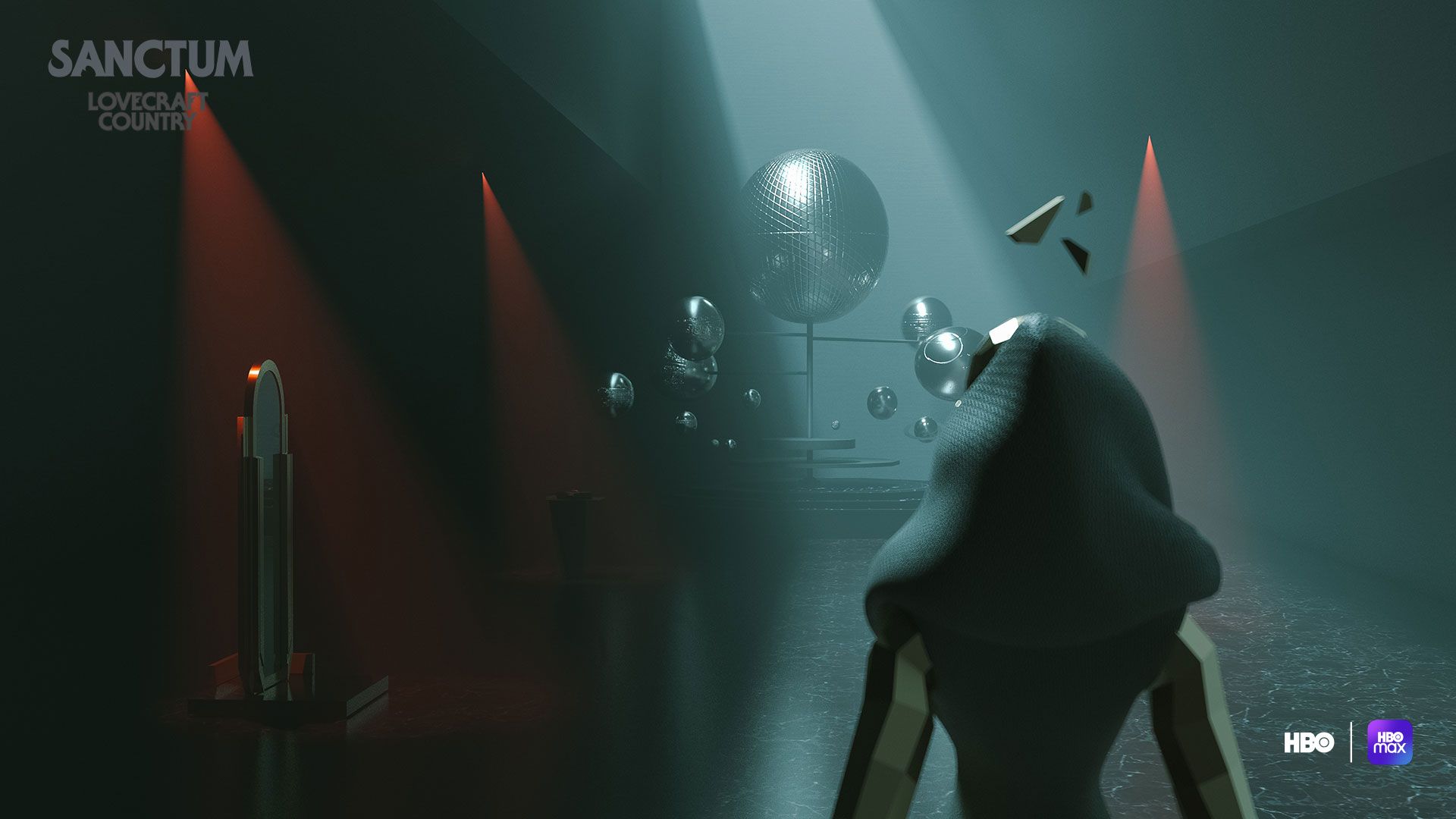
“Uncle George!” a spectator recognizing the narrator’s voice typed excitedly. “You’re my fave!”
Another viewer was less than enthused. “Okay--don’t have a headset. Giving this a few more minutes,” they said with an eyeroll emoji.
More voices chimed in: they wished they had a headset to play too. Some were content to watch things as they were. Others became frustrated they couldn’t jump in and enjoy the immersive experience right away.
The luxuriously minimal surroundings gave way to a stylized outdoor landscape. Muted colors, sharp cubed hills, a simple gradient sky, with an artistic stone platform floating above a smooth, serene lake. Smollett’s figure appeared with a flash of embers: she wore an Afropunk, abstract avatar featuring a woman wearing a high-neck gown with svelte curves. In a combination of her voice’s playback and timed mocap, her figure delivered a poem of Black consciousness in a duet with the classic recordings of James Baldwin.
It was a gorgeous scene that should have been perfect. Participating users on-screen floated upwards one by one, as if by Smollett’s behest. A camera panned cinematically at times while particles danced around like fireflies. Accompanying music played beautifully against the actress’s speech of freedom and heartbreak. There was almost a feeling of magic in the air, and even the chat was caught up by the speech in brief moments.
And yet, no major spark. What was missing?
“I get the art of the animated figure and the voiced poetry,” wrote a thoughtful viewer in the chatroom, “but these people standing aimlessly on platforms is kind of a miss, if we’re talking about deeper significance. So, like, seven people got to actually participate in this and we see them sitting around?”
They were referring to the users on the stream who were not acting. When not being presented with directions, the users were along for the ride. Sometimes, they didn’t know what to do, and so they did what a user would do in that moment: they watched. And that got boring, because Smollett’s figure was not always at the center of the scene. No viewer wants to watch a scene of viewers who are busy looking at someone else.
What was missing from Sanctum VR was what could not be understood by larger companies yet. Immersive plays and massive storytelling initiatives were only just being born within virtual reality. It was the smaller communities in VRChat who were already perfecting the secret spice of streamed performances: the one holding the camera needs to do something as well as recording what’s happening, and that something is to participate in telling the story as an actor.
To stand idle is to bore the viewer, and to bore the viewer is to deliver a story dead on its feet.
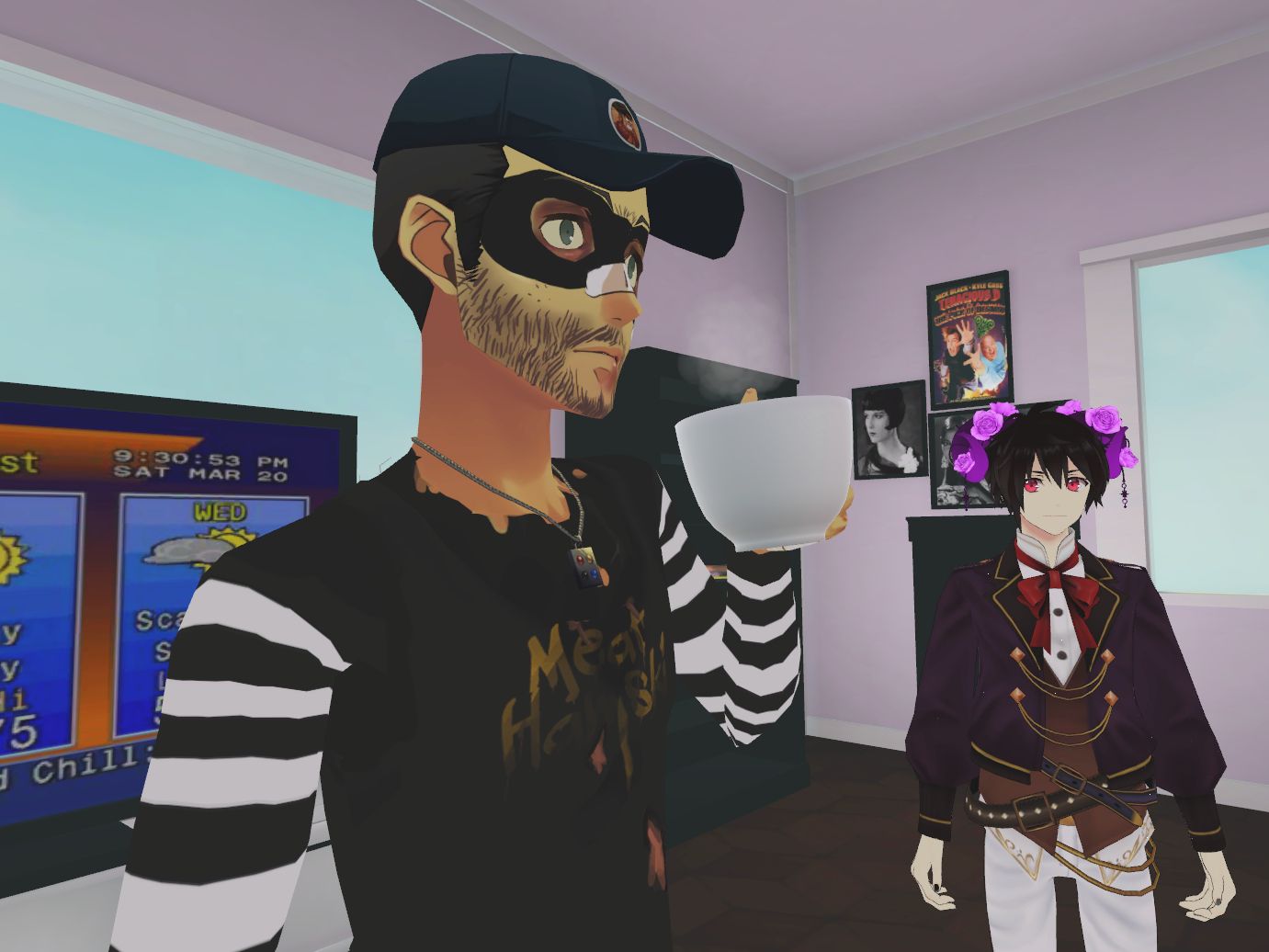
It’s three in the afternoon when I receive an invitation to join Meathamski in VRChat. He’s assembling a virtual music video with a few of his friends; the song is a parody of Moana’s “You’re Welcome” and is prerecorded by the entertainment streamer TFMJonny. In the lead role is Lucifer MStar, a renown map-builder of whom the song centers around. Various actors--including myself--are called in as extras to run jokes with the hero and push running gags along.
The shoot begins at The Great Pug, a tavern where Lucifer stands in the center while extras gawk at his relatively scrawny physique in a comedic fashion. Different takes are done as the music we cue our actions to is paused and played again, and Meathamski moves us all around for the best framing.
Users without full body tracking are placed in the front for the most dynamic poses. Half-body participants, meaning those only equipped with an HMD such as a Quest or Valve Index, are placed further back for shots where only the upper body will be visible. In some shots, it isn’t discernible if someone is in full-body or not, especially if they’re only using their head to glance in Lucifer’s direction. After all, the star of the show has full-body tracking, and the camera is mostly trained on him.
We change maps to an outdoor scene. Meathamski calls for someone who has a small avatar to step to the front, and film a shot with Lucifer to stare up at him in awe. The extras change to see who has a short enough appearance that will fit. I supplant my normal-height avatar, and in a flash, turn into an adorable moth-sized self with the same blue hair I always sport.
The director places his camera down behind me, asks me to stand in a predetermined spot, and freeze. Lucifer pauses a few steps away from me as we’re evaluated.
Meathamski peers through his viewfinder carefully to make sure everything lines up. “Perfect,” he says after a few moments. “We’ll use you.”
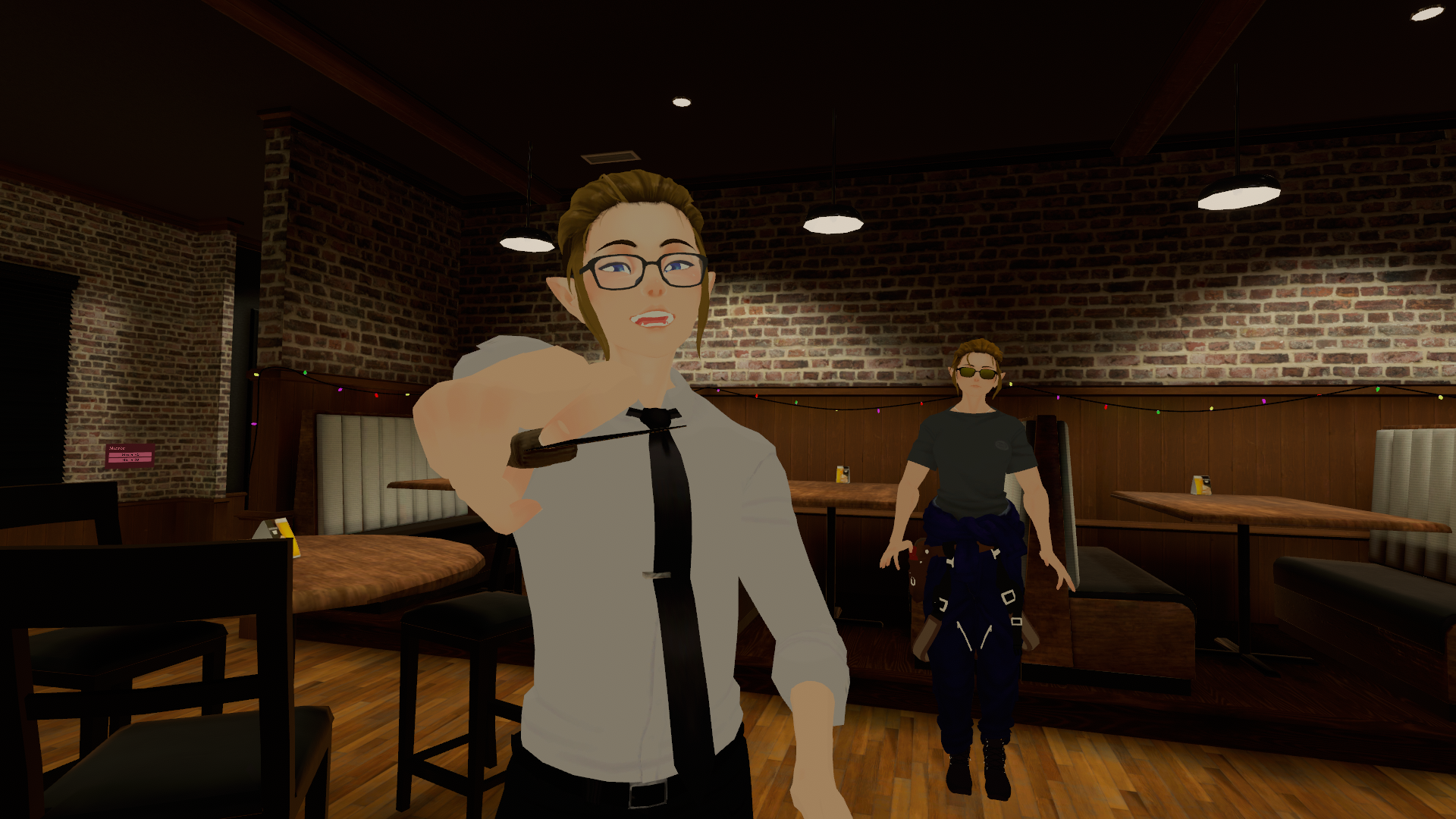
Meathamski’s avatar is tall and limber. Scrappy, dirty, downtrodden. His model is an extended edit of an existing one from a video game, taken and customized to represent his own character instead. Reflecting his tenor-level tone, his eyes belie uncertainty, vulnerability, deep-seated determination, and a desire to remain true to himself. Much of his own life story bleeds through to his acting. He is the underdog of humble beginnings who aspires to something greater.
“I had a pretty dead end job that made me feel like I couldn't be myself,” he explains about his real life, and transition to creating films in VR. “I wasn't growing as an individual or making enough money to move on. I felt kind of unappreciated. I'd go to work, stay quiet, finish the job, and then come home and work on my videos, paint, 3D model, 2D animate, or socialize with people in virtual reality. I was myself at my computer--and I think people appreciated it.”
He found himself within a creative space in VRChat, free to do whatever he desired. And so, he did what he was compelled to: use virtual reality to tell stories. He created videos of flirting with a life of crime, running into trouble with the law, landing in jail, only to break free and do it all again. Eventually, the comedy turned to grand adventures, and Meathamski found himself filming larger projects. Forays into ancient tombs, sneaking into upper-class casinos, and taking on espionage missions with hilarious results, guided by an event host and virtual game master named Gormundr.
“Gormundr would show up with an improvised roleplay event and throw me into a dark dungeon to fight off indescribable horrors for money,” Meathamski explains. “The people around me really helped me form my character.”
A month ago, Meathamski and Lucifer released a video on Youtube where Lucifer campaigns to become the “supreme leader” of VRChat, featuring a comedic skit of running a race where he was the only one on the ballot. Other actors, who had previously appeared on film with the pair, reacted with their own declarations of running a proper election to decide the winner. Before anyone could blink, the joke turned into a series of well-shot, comedic campaign videos from around the grid, with everyone from emerging voice talents to established Twitch stars throwing their hats into the race.
It culminated into a hosted event that ran on live improv. Fashioned as a parody debate, actors who signed up to participate lined the stage at set podiums, and engaged in a contest of who could pick up the best cues from one another and turn them into engaging jokes. Lightly touching on real politics, it was a contest between actors to see who had the best showmanship.
A vote-off to determine the winner will commence on September 1st. Because everything is streamed and filmed, cross-promotion happens organically, and audiences win no matter who they tune in to.
Which brings Meathamski to the music video project. No other campaign video in the contest so far is musical in nature. By pulling out the stops and getting a professional singer to provide their music, he and Lucifer know they’ll pull out ahead as the best entrants. Even others who are running against them help as extras in the production. There’s no actual rivalry, because the goal is to deliver an engaging story together.
“It's super easy to find extras or actors in VRChat because so many people seem to want to also be involved creatively. I think that's the main reason I loved creating videos in VRChat in the first place,” Meathamski says. “In real life, you'd have to pay someone or go out of your way to find someone like minded. But in VRChat, so many people seem to be willing to help create.”
And that includes Gormundr, the self-styled Viking and combat aficionado. But at the time of the music video shoot, he is somewhere else entirely.
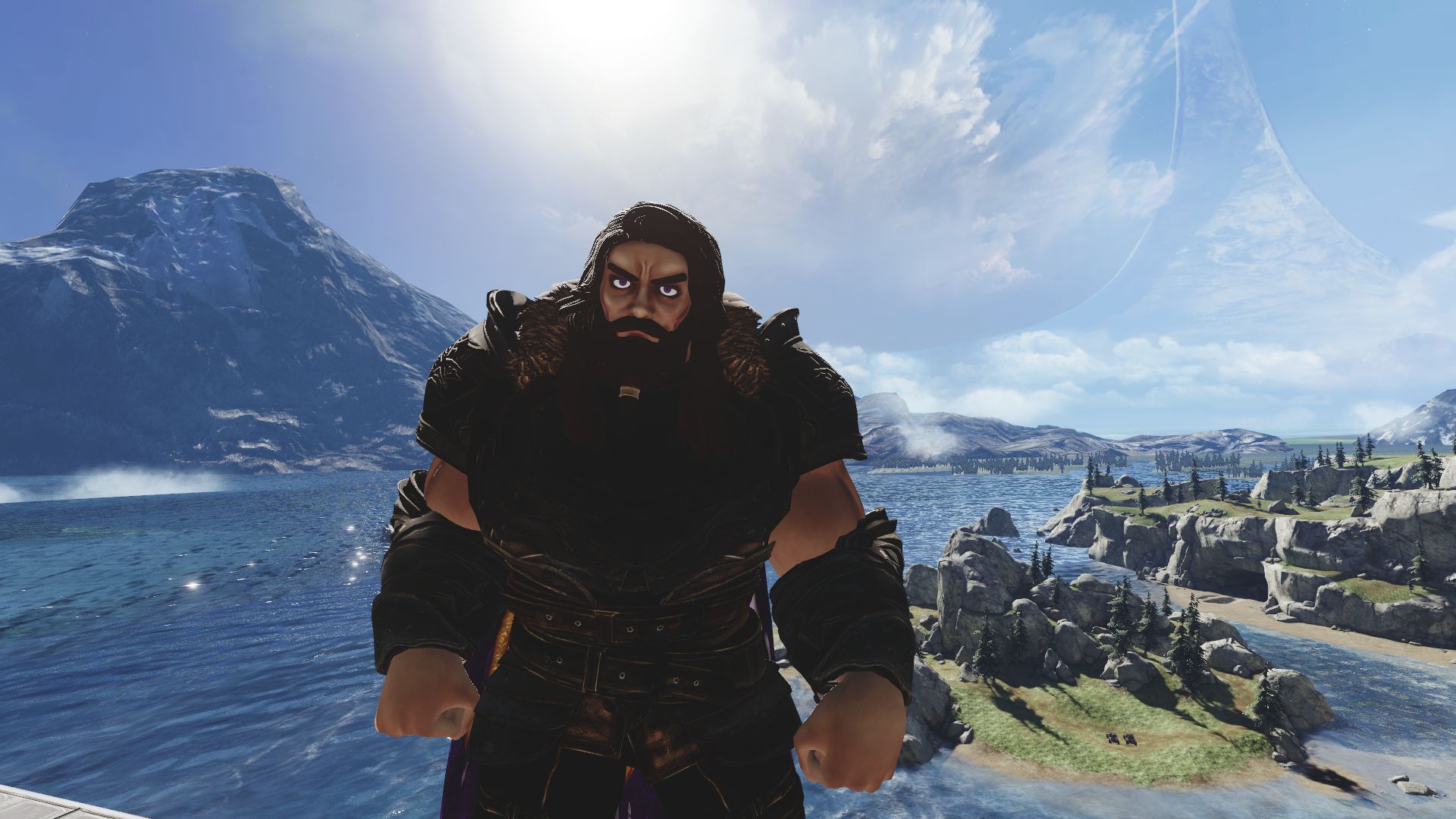
Gormundr’s booming voice is a natural for regaling tales and narrating exposition. He tells of VRChat users’ first attempts at implementing acting and improv into the platform as if it were yesterday.
“In 2017,” he says, “everyone was trying to make a name for themselves and stream. It was like a gold rush for content creators. VRChat public lobbies were full of them.”
One of the first attempts at organizing groups of performers was the Guild of Voice Actors, founded by Gormundr in the same year. It took a few tries for organizing performance-centric groups to stick, but finally Gormundr began holding courses on acting in fight scenes. The initiative was a success, and attracted more and more participants over time.
“My specialty is combat choreography, because I really think that there was a severely wrong way people were fighting in VR. I tried to help folks go from explaining all their moves verbally, to acting it out fluidly, creating a fight scene that flows and looks good. To have a bad combat section can ruin a whole scene, just as bad as awful dialogue.”
A visit to one of his virtual classes lands me in a small arena composed of stone. Half of the build is weathered, as if whatever society held their tournaments there cleared out long ago. Gormundr’s imposing, beared-bound figure is set upon a step, his students gathered around him. He is lecturing them on proper stance and form.
Eventually the class sides to the stone seats, and pairs are set up to perform one after another. While users build in particle effects into their avatars for certain attacks, what’s more important are how they act out an attack versus how the opponent reacts to it.
After a while of watching, the difference between a well-improvised fight and a poor one becomes clear. Gormundr’s wisdom is often delivered as the sparring commences. His students are always listening carefully.
“A fight between friends is always better than a fight between strangers, due to the fact that you have no clue if the other person has animations or is even decent at acting and reacting.”
One opponent takes the comedic route and executes a joke during a match, making others laugh while they bounce around and do their best to stay alive. They edge out in becoming the winner just by being more entertaining. The spar ends, and another pair steps up to practice in their place.
Gormundr goes on. “It always starts with an opener, a deciding first strike that sets the tone of the rest of the fight, and essentially two people just throw their all into a performance and grade one another on creativity, passion in their movement, and use of effects and avatar animations. In a more professional fight, the victory is decided by one person in their own head falling down after a 'finishing blow’ has been dealt, as a way of saying ‘We both put on a good performance, but I want to give you this victory because I enjoyed yours more’.”
If neither rival yields in a fight and insists on being the winner, the fight is dismissed and both participants are looked upon with disappointment. Reputation of good acting is important in roleplaying circles. There’s nothing better than being recommended for being a good performer.
Gormundr takes pride in how he teaches his courses, and how he develops ideas for acting initiatives. “I really do try to ensure everything I produce is always a good watch,” he says, referring to when he collaborates with emerging directors like Meathamski.
If a user wanted to, they could sign up for two different courses in VRChat that would enhance their acting ability. The first is Gormundr’s fight choreography course. The second, is at Gob’s Improv Emporium.
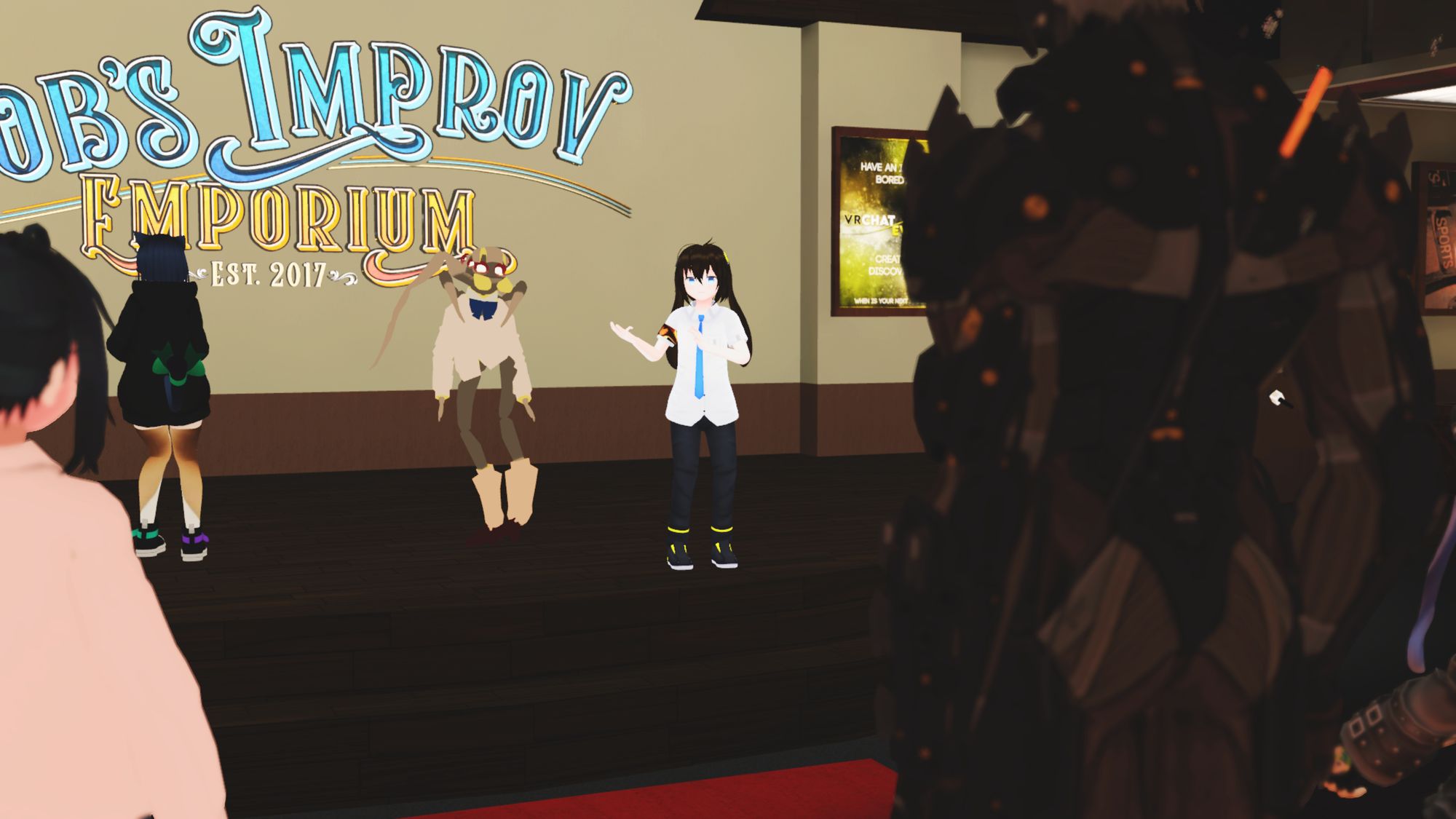
Goblox’s story of how he got into holding improv comedy courses in VRChat is similar to Gormundr’s establishment of fighting classes. In 2017, Goblox and his friends attempted to put on a play by using VRChat as their stage.
“At the time, we had a lot of difficulties getting it off the ground,” he recalls. “The actors were getting impatient, so I proposed that we start holding improv shows.” However, the first performances didn’t pan out so well. Dominated by whomever was the loudest, performances could either be short or long, and nothing was very well planned.
He decided to shape things up with a renewed format. “I saw a need for guidance, so when I was asked to take over, I brought that aspect into it with workshops and warm-up exercises. That completely changed things, and this began a whole journey down an improv education for all of us.”
A typical class at Gob’s Improv Emporium welcomes groups of interested students into a main lobby, decorated with knick-knacks and posters from past productions. After everyone is gathered, they’re welcomed down the hallway and into the virtual theatre house’s main stage area. This is the playhouse’s workshop spot, where the seating consists of comfortable sofas and the stage can hold its own productions without much of a hitch.
Goblox starts off by having students divide themselves into groups. Then, each group splinters into their own area of the theatre to run exercises. Different scenarios are given as prompts, students pair up, and perform with feedback given after. The goal is to get students to learn to pick up cues from their partners more efficiently, react well, and keep the energy going between them. The better the flow of energy, the better the performance overall.
While the Improv Emporium is a wild success that’s even done charity shows for VRCon, Goblox had no experience at all before arriving on the platform. “Before VR, I had no formal improv training. Everything I know now is entirely what I've learned from our group. For most of us here, our improv journey started entirely in VR.”
“Do you believe improv to be one of the building blocks for acting in general?” I ask, watching the group of students splinter and run through scenarios again and again.
Goblox’s small, friendly stature is nothing but good-natured in appearance. It’s easy for him to convey an affability in his answers. “I actually believe they both help each other equally. You have to learn to look and sound natural in scenes, in both improv and in acting in general. If you look like you're acting, then everyone's just gonna focus on how you are trying to act, and failing. So learning how to act natural is a big part of it. The better you are at this, the better you'll do in both disciplines.”
And just as with Gormundr’s fight choreography course, Goblox’s improv workshops have had a positive effect on the students who enroll. “People who learn with us get involved with roleplay events, acting gigs, hosting other VR events, and we even just recently had someone announce they got a promotion at their job. They thanked our improv group for helping them build the skills necessary to make that happen.”
Students who attend either course go on to filter into other parts of VR with their talents, or even real life roles on stage or screen. But sometimes, it’s the opposite. Real-world talent is also starting to filter into VR, and it isn’t just popular networks with experimental productions doing so.
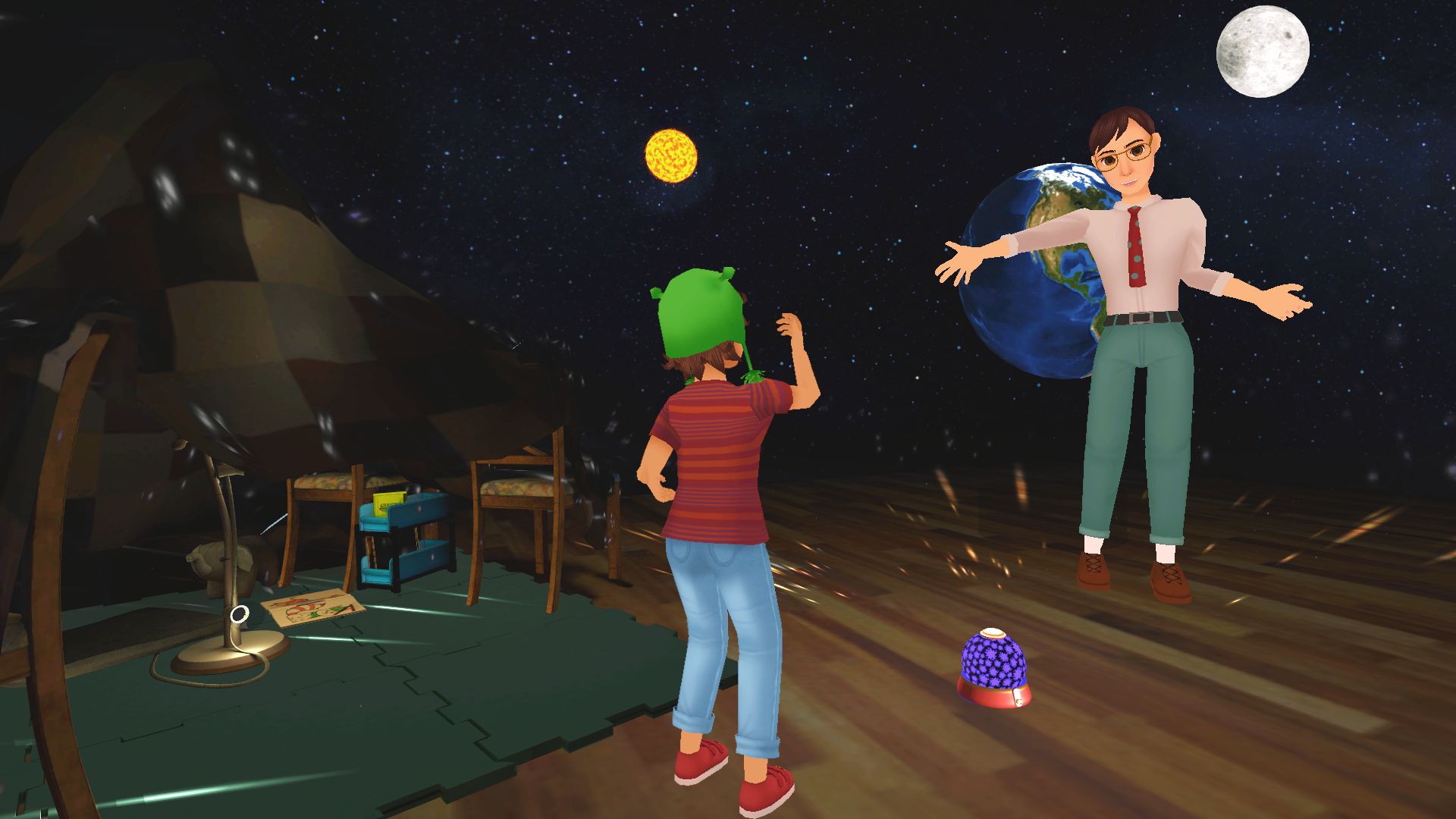
Immersive theatre was not invented in virtual reality. Originating from the 19th century practice of call-and-response during plays, the art of immersive storytelling morphed into its modern form in the early 2000s. In an immersive production, the viewer is part of the play and can actively affect what happens to some degree. The discipline began to accelerate with the advent of VR becoming available for mainstream consumption.
Deirdre Lyons remembers in 2020, when her usual work with real-life immersive theatre companies in Los Angeles led her to be cast in Tyra Banks’ production of Model Land. Just as it was to debut, Coronavirus hit. Lyons was out of a job--but fortunately, had also picked up work as an actor for a VR-based project called The Under Presents.
“Model Land let all the actors go without ever having opened, although I hope one day it will,” remembers Lyons. “But this very strange and miraculous world of The Under Presents was still open, a bright little spark of light in a very dark world for many. Tender Claws, the company that created The Under Presents, sent out into the world this wonderous bit of magic exactly when all of us who participated in The Under needed it.”
Her work grew from there. The Under Presents gave way to The Under Presents: Tempest, and then Finding Pandora X. Then, she began to produce her own shows: PARA, Krampasnacht, which became a finalist for the PGA Innovation Award, and The Severance Theory: Welcome To Respite. Much like Meathamski, virtual reality gave Lyons even more space to shift into the control seat as well as expanding her acting resume. Now, she’s a power player within the sphere.
Brendan Bradley is another real-life actor with a considerable amount of experience, who was drawn to virtual reality for its possibilities and alternate space in the face of the pandemic. A performer who most recently was a voice actor for Resident Evil Village, he’s continued to experiment in various ways to bring theatre to VR.
Bradley recalls turning to Unity and virtual reality to bring San Diego Comic Con attendees into first-person view for the main character of his original sci-fi series, SONA. “My first professional consideration of virtual reality was at VRLA 2018. We had built a spaceship in our one bedroom apartment for filming and looking for a way to ‘scale’ the show and universe.”
Back then, he used a Lenovo Mirage Solo to help bring his work to life. “It was a hit,” Bradley says. “I immediately began integrating real-time motion capture and avatars into my indie film pipeline for a feature film adaptation of Macbeth, set in the world of an indie VR game company.”
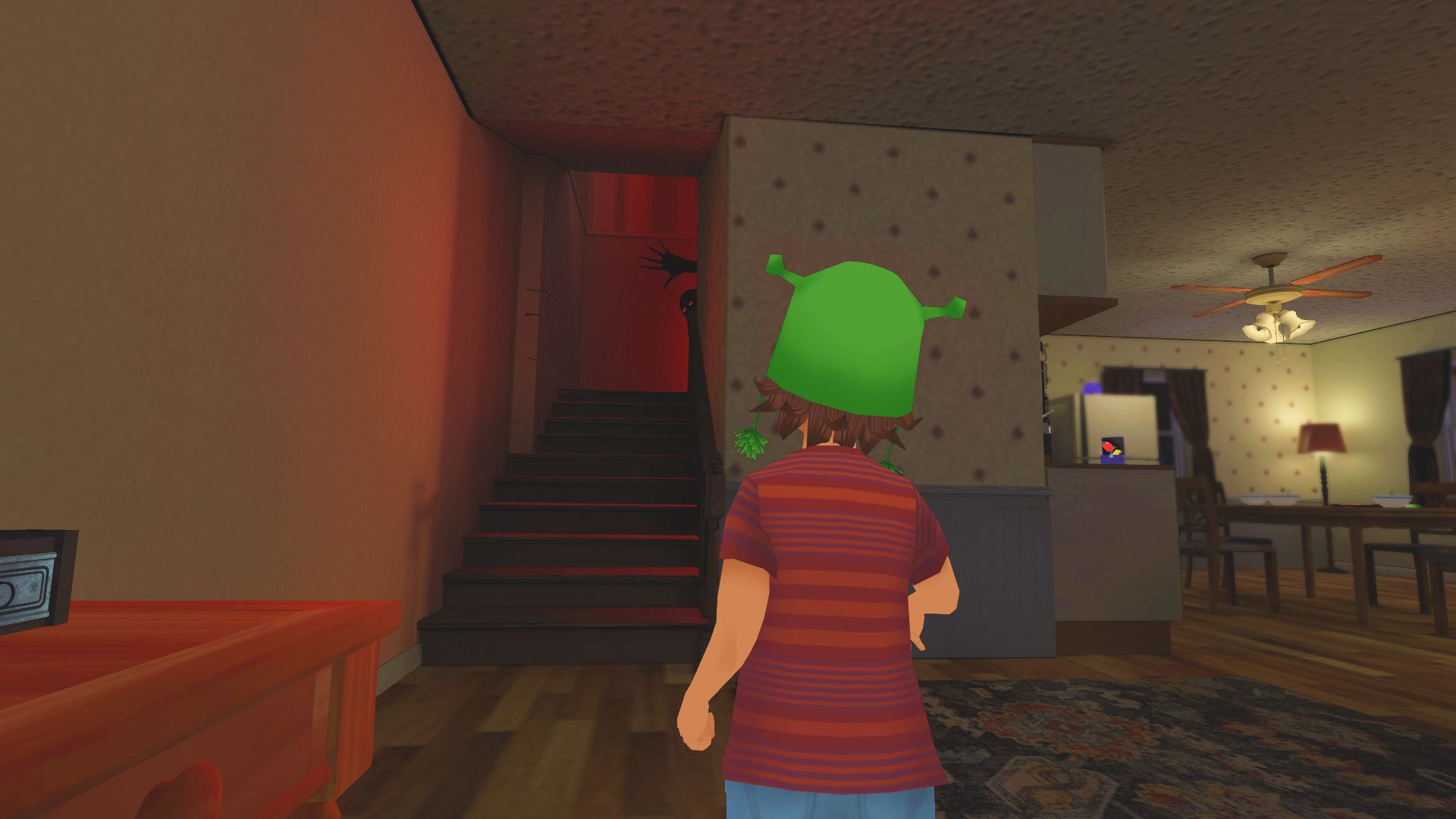
Both Bradley and Lyons will be respectively joining and returning for The Severance Theory: Welcome To Respite. Both are excited for the expanded showings the production will be receiving, as well as the development of its second installment for viewers to experience.
“Welcome To Respite is the first VR project I've been a part of that I am not part of the original creative team, and I absolutely welcome the opportunity to put all my focus into being a good ensemble member and learn from some of the biggest innovators in the space,” says Bradley.
As for the overall future of immersive theatre and VR, Lyons is hopeful. “We are at the very beginning of creating performance in VR, and with VR in general. We haven’t even scratched the surface of what it can do and what it might become. I believe the future here is bright and wide open as creatives enter this new storytelling platform.”
The informational map in VRChat for Welcome To Respite glimmers with credits and cast photos, and shows off a few example avatars and furniture sets the modeling crew created to bring the production to life. In virtual reality, 3D creation programs allow art crews to become set design, costuming, and makeup for the actors to do their job.
Across the grid, another immersive storytelling community also relies on extensive map design to house the performers who call their locales home, gaining thousands of viewers with weekly performances. Its name is Fractured Thrones.
Fractured Thrones has existed for some time now. Centered around a medieval fantasy theme, its characters are the type you might come across in a Tolkien novel. Many performers are dressed down as peasants and common folk, giving a further sense of gravity to their creations. Storytelling sessions for Fractured Thrones are often streamed on Twitch, with users clicking directly on streams to find what they want to watch.
Lyra121 has been roleplaying in Fractured Thrones for a few years. Experienced in performance and avatar creation for roleplayers, Lyra understands why players take to Twitch so easily to stream their roleplaying and collaborative performances.
“In all honesty,” Lyra says, “it's the simplicity paired with the need to share stories. Some crazy stories happen in roleplay and we want to tell folks of these amazing experiences, but writing it all down or editing a video to retell the story is terribly time consuming. Meanwhile streaming it straight to Twitch allows other folks to experience it at the same time as you and your characters. Most players have no idea what the DMs plan for sessions, so they are right with the fans when crazy things happen to characters, and that’s amazing to experience.”
There’s also the idea that avatar design is akin to costume creation in traditional theatre. “It's actually how I have to describe it to my family that doesn’t really understand how games are, so I end up saying something along the lines of ‘It's a digital costume people wear when hanging out with their friends’.”
When creating a design for an avatar, Lyra explains that optimization is important. A roleplay map can be filled with 60 to 100 people all streaming their performances at the same time, and loading an avatar that is resource-intensive can become too demanding of a player’s computer. Lyra works to make sure the avatars they create have a recognizable silhouette, and as effectively optimized as possible without making it look low-quality.
The future of theatre, roleplay, and immersive storytelling is bound to intersect further, yet also splinter into different levels of engagement. Some will keep it as a hobby, what they call their own for personal enjoyment. Others will want to push traditional theatre as far as virtual reality will let it go, in order to keep some preservation of what’s always been done. Others will examine the two communities, and find ways to fuse them even further.
And yet, one article isn’t enough to cover the stories still worth digging into: NeosVR’s latest foray into theatrical productions, The MetaMovie Project. Derailed, a virtual film directed by AcmeJack in VRChat, which was featured in a film festival and highly celebrated. Initiatives by solo and groups of coders to create and host their own performance art worlds in virtual reality. Within a year, some of the technology used to bring productions to life now will have radically changed. Each film festival is like a checkpoint; we gather, show off what we’ve done, reminisce, and wait for the future.
The next best method is always developing. As Deirdre Lyons compares it: “Like film in the 20’s and computing in the 70’s, it took decades to figure out the best uses for the computer and now almost every household has one, decades to figure out the best way of making a movie and now we have fast cuts and computer-generated graphics.”
One day, we’ll figure out the best way to deliver a virtual theatre experience too. Until then, we’re having a great time figuring it out.
Meathamski and Gormundr are on Twitter respectively as @meathamski and @gormundr.
You can find out about Gob’s Improv Emporium at gobsimprov.com.
The Severance Theory: Welcome To Respite sells tickets for their productions at theseverancetheory.com.
Lyra121 streams avatar creation on Twitch: twitch.tv/lyra121.
Want to support deep-diving metaverse journalism? You can subscribe to our Patreon here.
